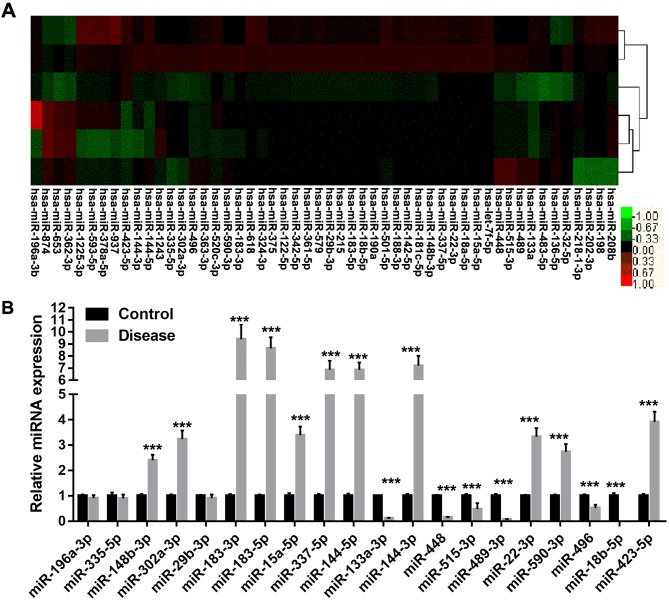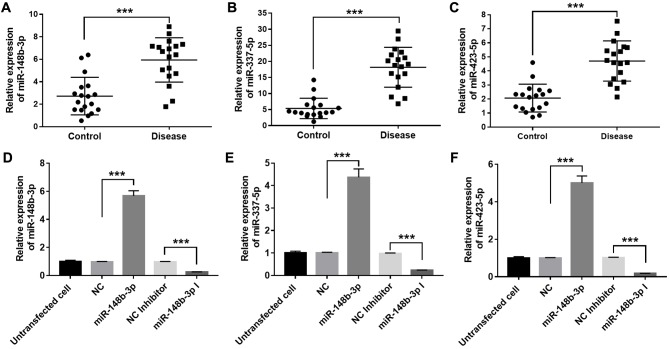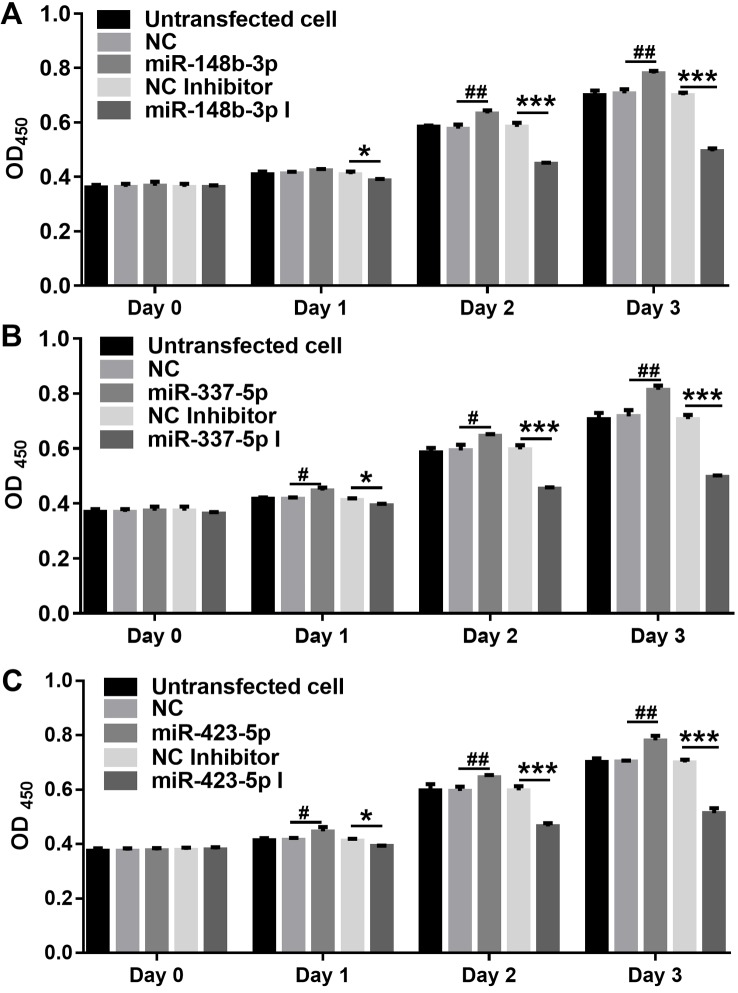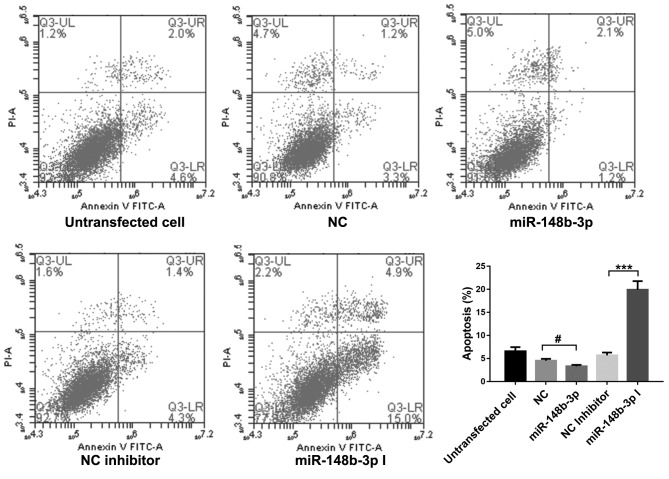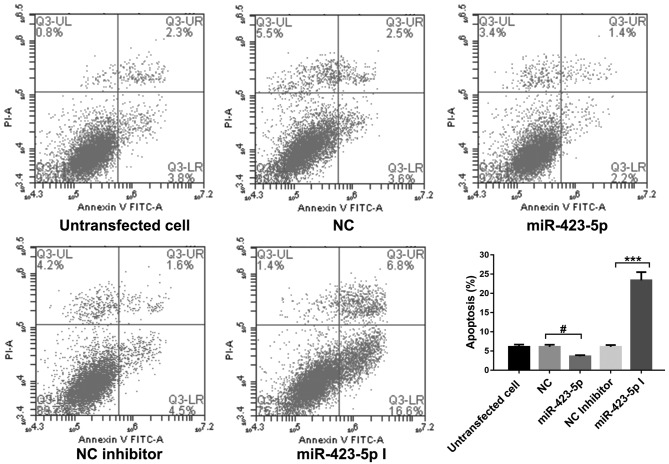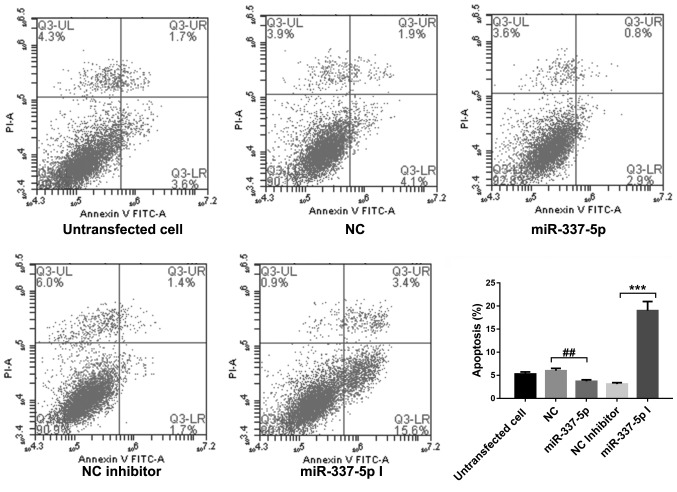Abstract
MicroRNAs (miRNAs/miRs) have key roles in various physiological and pathological processes by regulating the expression of specific genes. The identification of miRNAs involved in bone metabolism may provide insight into the expression of genes associated with the development of alveolar ridge atrophy. In the present study, the miRNA expression profiles in alveolar ridge atrophy and normal tissue samples were investigated by miRNA microarray analysis. Among the 52 differentially expressed miRNAs identified, the expression levels of 20 selected miRNAs in the alveolar ridge atrophy and normal tissue samples were verified by reverse transcription-quantitative polymerase chain reaction. The results indicated that the expression levels of 11 miRNAs were significantly different between alveolar ridge atrophy and normal tissue samples; however, only three of them (miR-148b-3p, miR-337-5p and miR-423-5p) were previously reported to be involved in bone metabolism. In vitro, miR-148b-3p, miR-337-5p and miR-423-5p mimics promoted the proliferation and inhibited apoptosis of bone marrow mesenchymal stem cells from orofacial bone (OMMSCs), while antisense inhibitors of these miRNAs had the opposite effect. In conclusion, the present study indicated that these miRNAs are involved in the pathogenesis of alveolar ridge atrophy. miR-148b-3p, miR-337-5p and miR-423-5p promote the proliferation of OMMSCs and inhibit their apoptosis. The present results provide a novel perspective for understanding the pathogenesis of alveolar ridge atrophy.
Keywords: alveolar ridge atrophy, miRNA, proliferation, apoptosis, bone marrow mesenchymal stem cells
Introduction
According to a recent epidemiological survey, the rate of the loss of one or more teeth in individuals is 6.45% (1). With the aging of the population in China, the incidence of tooth loss exhibits yearly increases. Severe alveolar bone loss is commonly observed in patients with periodontal disease or in those who wear dentures for an extended period, which may cause atrophy of the alveolar ridge (2). The significant reduction in the contact area of the mandibular tissue in patients with severe atrophy of the alveolar ridge makes denture retention difficult and the occlusal ability of these patients frequently remains poor after repair (3). This has a severe impact on the physical and mental wellbeing of the affected patients, thereby impairing their quality of life. Therefore, determining the specific pathophysiological mechanisms underlying alveolar atrophy has become an issue of prime importance. A recent study has revealed that the pathophysiological mechanisms underlying alveolar ridge atrophy are associated with a condition wherein the osteoclast metabolism is higher than the osteoblast metabolism (4). Studying alveolar bone-associated osteoclasts, their osteogenic metabolism and the underlying regulatory mechanisms using molecular biology techniques will help in the elucidation of the causes of alveolar ridge atrophy.
MicroRNAs (miRNAs/miRs) are a class of small non-coding RNAs of 19–25 nucleotides in length that are capable of regulating gene expression post-transcriptionally by binding to the 3′-untranslated region of their target mRNAs (5). miRNAs regulate the expression of ~30% of all human genes (6). Increasing evidence has indicated that miRNAs have important roles in physiological development and in pathogenesis (7). miRNA expression profiles are useful tools to study the molecular mechanisms of diseases (8). For instance, miRNA expression profile analysis has indicated that miR-148a-3p is markedly upregulated during osteoclastogenesis of human CD14+ peripheral blood mononuclear cells (PBMCs). Overexpression of Homo sapiens (hsa)-miR-148a-3p in CD14+ PBMCs facilitated osteoclastogenesis, whereas suppression of hsa-miR-148a-3p expression inhibited it (9). Several miRNAs that participate in osteoclast formation, differentiation, apoptosis and resorption have been identified (9–11). For instance, miR-148b directly targets the gene encoding noggin, which is involved in the regulation of bone morphogenetic protein 2-induced osteogenic differentiation and bone formation (12). Photo-activated miR-148b nanoparticle conjugates improve the closure of critical-sized calvarial defects in mice (13). Yoshitaka et al (14) have indicated that miR-337-5p was significantly downregulated in patients with chondrosarcoma as well as in chondrosarcoma cell lines. Although miRNAs appear to be critical regulators of bone-associated osteoclast metabolism and osteogenesis, few studies have examined their roles in alveolar ridge atrophy.
Recently, stem cell-based tissue engineering has been successful in reconstructing several tissue types, including dental tissues (15). Adult bone marrow mesenchymal stem cells (MMSCs) are not only easily obtained and expanded in culture but also have the ability of multilineage differentiation, i.e., these cells are able to differentiate to form a variety of tissue types, including bone, cartilage, tendon and adipose tissues (16). MMSCs from orofacial bone (OMMSCs) are the ideal seeding cells for the reconstruction of the alveolar ridge tissue (17). It is thus essential to explore the role of miRNAs in OMMSCs.
The present study aimed to identify miRNAs that may be associated with the mechanisms underlying alveolar ridge atrophy. Hence, differentially expressed miRNAs between alveolar ridge atrophy and normal tissue samples were identified by miRNA microarray analysis. Various deregulated miRNAs in alveolar ridge atrophy were then confirmed by reverse transcription-quantitative polymerase chain reaction (RT-qPCR) analysis. Subsequent in vitro functional assays indicated that miR-148b-3p, miR-337-5p and miR-423-5p promote the proliferation of OMMSCs and inhibit their apoptosis.
Materials and methods
Sample collection
Alveolar ridge atrophy tissue samples were obtained from elderly male patients (aged >70 years), who required repair of the alveolar ridge. Normal alveolar ridge tissue samples were obtained from adult male patients (age, 25–35 years) who required removal of wisdom teeth. All participants were recruited between January 2013 and December 2013 from the Chinese PLA General Hospital (Beijing, China). In total, 21 alveolar ridge atrophy tissue samples from 21 different patients and 21 alveolar ridge normal tissue samples from 21 different healthy volunteers were obtained. All tissue samples were immediately snap-frozen in liquid nitrogen and stored at −80°C until total RNA extraction. A total of 3 alveolar ridge atrophy tissue samples and 3 alveolar ridge normal tissue samples were randomly selected for the miRNA microarray analysis. The present study was performed according to principles of the Helsinki Declaration from 1975 and its revision from 1983. The use of the aforementioned samples in the present study was approved by the Committees for Ethical Review of Research Involving Human Subjects of the Chinese PLA General Hospital (Beijing, China). Written informed consent was received from each tissue donor.
RNA extraction
Total RNA was extracted from the frozen tissue using the TRIzol reagent (Invitrogen; Thermo Fisher Scientific, Inc., Waltham, MA, USA) according to the manufacturer's protocol. The total RNA in the sample was quantified using a NanoDrop 2000 spectrophotometer (Thermo Fisher Scientific, Inc.) and the RNA integrity was evaluated by agarose gel electrophoresis.
miRNA microarray assay
The miRNA microarray assays were performed using an Affymetrix miRNA array system (Affymetrix; Thermo Fisher Scientific, Inc.) following the manufacturer's protocol in order to screen for differential expression profiles of miRNA in the alveolar ridge atrophy tissue samples vs. the normal tissue samples. In brief, the total RNA was subjected to Poly A-tailing and then labeled with biotin using a FlashTag Biotin HSR RNA Labeling Kit (Affymetrix; Thermo Fisher Scientific, Inc.). Hybridization was then performed using the Affymetrix GeneChip miRNA 4.0 (Affymetrix; Thermo Fisher Scientific, Inc.). The hybridization signals were produced using the Affymetrix Command Console Software 3.0 (Affymetrix; Thermo Fisher Scientific, Inc.). The raw data were normalized using the Robust Multichip Average algorithm. The differentially expressed miRNAs were identified by screening for fold changes in expression and by the P-value (fold-change, >1.5; P<0.05). To evaluate the correlations between the results of the individual experiments, a hierarchical clustering analysis was performed using Cluster 3.0 software (open source, http://bonsai.hgc.jp/~mdehoon/software/cluster/software.htm).
RT-qPCR
First, the differential expression of 20 selected miRNAs in the alveolar ridge atrophy vs. normal tissue samples identified in the microarray assay was validated by RT-qPCR. The relative expression levels of three miRNAs (miR-148b-3p, miR-337-5p and miR-423-5p) in 18 pairs of alveolar ridge atrophy and normal tissue samples, excluding the three pairs used for the microarray assay, were measured by RT-qPCR. RT was performed using the TaqMan® MicroRNA Reverse Transcription Kit (Applied Biosystems; Thermo Fisher Scientific, Inc.) according to the manufacturer's instructions. Real-time PCR was performed using SYBR Green (Takara Bio, Inc., Dalian, China) and a 7500 real-time PCR system (Applied Biosystems; Thermo Fisher Scientific, Inc.). A 20 µl total volume of the qPCR mixture was prepared with 5 µl 20×-dilution RT products, 500 nM of forward and reverse primers and 2× SYBR Green qPCR SuperMix (Invitrogen; Thermo Fisher Scientific, Inc.). Each sample was tested in triplicate. The thermocycling conditions were as follows: 50°C for 2 min, 95°C for 2 min, followed by 45 cycles (at 95°C for 5 sec and 55°C for 20 sec). The primers were synthesized by Takara Bio, Inc. and their sequences are listed in Table I. U6 RNA served as the endogenous control. Relative miRNA expression was calculated using the 2−ΔΔCq method (18). All experiments were performed in triplicate.
Table I.
Sequences of primers used for polymerase chain reaction, as well as miRNA mimics and inhibitors.
| Name | Sequence (5′-3′) |
|---|---|
| miRNA-RT | GTTGGCTCTGGTGCAGGGTCCGAGGTATTCGCACCAGAGCCAACCTCAGG |
| miR-196a-3p-F | GGACGGCAACAAGAAACTG |
| miR-188-3p-F | TTTCTCCCACATGCAGGG |
| miR-335-5p-F | GAGGTCAAGAGCAATAACGAA |
| miR-148b-3p-F | GGGTCAGTGCATCACAGAA |
| miR-302a-3p-F | CGGTAAGTGCTTCCATGTTT |
| miR-29b-3p-F | GCAGTAGCACCATTTGAAATC |
| miR-183-3p-F | AGGAGTGAATTACCGAAGGG |
| miR-183-5p-F | GAGGTATGGCACTGGTAGAA |
| miR-15a-5p-F | TTTGGTAGCAGCACATAATGG |
| miR-337-5p-F | CCCGAACGGCTTCATACA |
| miR-144-5p-F | CGGGCGGATATCATCATATAC |
| miR-133a-3p-F | TCCTTTGGTCCCCTTCAAC |
| miR-144-3p-F | GGCGGGTACAGTATAGATGA |
| miR-448-F | CGGGTTGCATATGTAGGATG |
| miR-515-3p-F | GTGGAGTGCCTTCTTTTGG |
| miR-489-3p-F | GCGGGTGACATCACATATAC |
| miR-22-3p-F | GGAAAGCTGCCAGTTGAAG |
| miR-590-3p-F | CGGGGGGCTAATTTTATGTATAA |
| miR-496-F | GTGCTGAGTATTACATGGCC |
| miR-18b-5p-F | GTGTAAGGTGCATCTAGTGC |
| miR-423-5p-F | GAGGGGCAGAGAGCGA |
| U6_F | TTCCTCCGCAAGGATGACACGC |
| miR-148b-3p mimic | UCAGUGCAUCACAGAACUUUGU |
| miR-148b-3p inhibitor | ACAAAGUUCUGUGAUGCACACUGA |
| miR-337-5p mimic | GAACGGCUUCAUACAGGAGUU |
| miR-337-5p inhibitor | AACUCCUGUAUGAAGCCGUUC |
| miR-423-5p mimic | UGAGGGGCAGAGAGCGAGACUUU |
| miR-423-5p inhibitor | AAAGUCUCGCUCUCUCUGCCCCUCA |
| NC mimic | UCACAACCUCCUAGAAAGAGUAGA |
| NC inhibitor | UCUACUUCUUUCUAGGAGGUUGUGA |
miR/miRNA, microRNA; NC, negative control; F, forward primer; RT, reverse transcription PCR.
Cell culture and transfection
Human OMMSCs were obtained from the Cell Bank of the Chinese Academy of Sciences (Shanghai, China). The OMMSCs were cultured in α-minimal essential medium (Gibco; Thermo Fisher Scientific, Inc.) containing 10% fetal bovine serum (Gibco; Thermo Fisher Scientific, Inc.) and 1% penicillin-streptomycin (Invitrogen; Thermo Fisher Scientific, Inc.) in a humidified incubator with a 5% CO2 atmosphere at 37°C. The human OMMSCs were grown in attached culture. The miRNA mimics, inhibitors (antisense), and negative controls (NC) were purchased from RiboBio (Guangzhou, China) and their sequences are listed in Table I. The OMMSCs were transfected using Lipofectamine RNAiMAX (Invitrogen; Thermo Fisher Scientific, Inc.) according to the manufacturer's protocol. At 48 h after transfection, the cell proliferation and apoptosis assays were performed.
Cell proliferation assay
Cell proliferation was assessed using a Cell Counting Kit (CCK)-8 assay kit (Beyotime Institute of Biotechnology, Shanghai, China) following the manufacturer's protocol. Following culture for 24 h, OMMSCs were placed in 96-well plates at a density of 5×103 cells per well and transfected with the miRNA mimics, inhibitors and NCs, respectively, with each condition performed in triplicate. After culturing for 0, 1, 2 or 3 days, 10 µl CCK-8 reagent was added to each well followed by gentle agitation. The cells were then cultured at 37°C in a 5% CO2 atmosphere for 4 h. Subsequently, the absorbance was measured at 450 nm using an MK3 microplate reader (Thermo Fisher Scientific, Inc.).
Apoptosis assay using flow cytometry
OMMSCs transfected with miRNA mimics, inhibitors and NCs, respectively, were used in this experiment. Cell pellets (5×103 cells) were re-suspended in 500 µl binding buffer. Subsequently, 1.25 µl annexin V-fluorescein isothiocyanate and 10 µl propidium iodide were added to the cell suspension (0.5 ml) and the cells were cultured in the dark for 15 min at 25°C. Cell apoptosis was then assessed by flow cytometry (BD Biosciences, San Jose, CA, USA). Each experiment was performed in triplicate.
Statistical analysis
Statistical analysis was performed using SPSS 19.0 software (IBM Corp., Armonk, NY, USA). Values are expressed as the mean ± standard deviation. A moderated t-test was performed to identify miRNAs that were differentially expressed between the alveolar ridge atrophy and normal tissue samples. The statistically significant differences of results obtained by RT-qPCR analysis and the cell proliferation and apoptosis assays, were assessed by an independent-samples t-test. P<0.05 was considered to indicate a statistically significant difference.
Results
Expression profiling of microRNA in tissue samples
To identify whether miRNAs have a role in alveolar ridge atrophy, a miRNA microarray analysis was performed to examine the global miRNA expression in alveolar ridge atrophy and normal tissue samples. To identify differentially expressed miRNAs, moderated t-tests were performed, and 52 miRNAs whose expression levels were considerably different between the alveolar ridge atrophy and normal tissue samples were retrieved. A map of unsupervised hierarchical clustering analysis of the differentially expressed miRNAs is presented in Fig. 1A. The results indicated that various miRNAs may be involved in alveolar ridge atrophy. To validate the microarray data, RT-qPCR was performed to detect the differential expression of 20 selected miRNAs (fold change, >2) between the alveolar ridge atrophy and normal tissue samples that were used in the microarray assay (Fig. 1B). The expression of 11 miRNAs (miR-148b-3p, miR-302a-3p, miR-183-3p/5p, miR-15a-5p, miR-337-5p, miR-144-3p/5p, miR-22-3p, miR-590-3p and miR-423-5p) was significantly upregulated (fold change, >2) in the alveolar ridge atrophy tissues samples compared with that in the normal alveolar ridge tissue samples (P<0.05), while the expression of five miRNAs (miR-133a-3p, miR-448, miR-515-3p, miR-489-3p and miR-18b-5p) was significantly downregulated (fold change, <1/2; P<0.05).
Figure 1.
Differentially expressed miRNAs in alveolar ridge atrophy and normal tissue samples were analyzed by miRNA microarray and RT-qPCR. (A) Heat map of unsupervised hierarchical clustering analysis based on the 52 miRNAs identified in the tissue samples. (B) RT-qPCR analysis of the expression of 20 selected miRNAs in the alveolar ridge atrophy and normal tissue samples. ***P<0.001 vs. control Values are expressed as the mean ± standard deviation. RT-qPCR, reverse transcription-quantitative polymerase chain reaction; miRNA, microRNA; hsa, Homo sapiens.
Relative expression of miR-148b-3p, miR-337-5p and miR-423-5p in tissue samples
Studies have indicated that certain miRNAs, including miR-148b-3p, miR-337-5p and miR-423-5p, participate in bone metabolism. In the present study, the expression levels of these 3 miRNAs were significantly upregulated in the alveolar ridge atrophy tissue samples compared with those in the normal alveolar ridge tissue samples (P<0.05). Thus, miR-148b-3p, miR-337-5p and miR-423-5p were selected for further experiments, including the determination of their relative expression levels in alveolar ridge atrophy or normal tissue samples and cellular physiological function assays. To confirm the expression levels of miR-148b-3p, miR-337-5p and miR-423-5p in alveolar ridge atrophy and normal alveolar ridge tissue samples, their relative expression levels in 18 pairs of alveolar ridge atrophy and normal tissue samples, excluding the three pairs used in the microarray assay, were measured using RT-qPCR. The results indicated that the relative expression levels of miR-148b-3p, miR-337-5p and miR-423-5p in the alveolar ridge atrophy tissue samples were higher than those in alveolar ridge normal tissue samples (P<0.001), which is consistent with the microarray data (Fig. 2A-C). To further assess the biological functions of miR-148b-3p, miR-337-5p and miR-423-5p in the OMMSCs, these miRNAs were ectopically overexpressed by transient transfection with miR-148b-3p, miR-337-5p and miR-423-5p mimics, respectively, and furthermore, knockdown of these miRNAs was achieved via transient transfection with miR-148b-3p, miR-337-5p and miR-423-5p inhibitors, respectively. It was experimentally verified that the expression levels of miR-148b-3p, miR-337-5p and miR-423-5p were significantly enhanced after transfection with their respective mimics, while their expression levels were significantly decreased after transfection with their respective inhibitors (P<0.001; Fig. 2D-F).
Figure 2.
miR-148b-3p, miR-337-5p and miR-423-5p expression analyzed by reverse transcription-quantitative polymerase chain reaction. (A-C) Relative expression levels of (A) miR-148b-3p, (B) miR-337-5p and (C) miR-423-5p in the alveolar ridge atrophy and the normal tissue samples. (D-F) Relative expression levels of (D) miR-148b-3p, (E) miR-337-5p and (F) miR-423-5p in bone marrow mesenchymal stem cells from orofacial bone at 24 h following transfection. Values are expressed as the mean ± standard deviation. ***P<0.001 vs. control/NC. NC, negative control; miR, microRNA.
miR-148b-3p, miR-337-5p and miR-423-5p promote OMMSC proliferation
The proliferation of OMMSCs was determined by the CCK-8 assay (Fig. 3). On the third day after transfection with the mimics, the proliferative ability of the OMMSCs was markedly enhanced compared with that in the NC-transfected group (P<0.05). By contrast, on the third day following transfection with the inhibitors, the proliferative ability of the OMMSCs was markedly reduced compared with that in the NC-transfected group (P<0.01). The results indicated that miR-148b-3p, miR-337-5p and miR-423-5p promote the proliferation of OMMSCs.
Figure 3.
Proliferation of OMMSCs analyzed by the Cell Counting Kit-8 assay. (A) Proliferation of the OMMSCs transfected with NC, miR-148b-3p mimics, NC inhibitor or miR-148b-3p inhibitor. (B) Proliferation of the OMMSCs transfected with NC, miR-337-5p mimics, NC inhibitor or miR-337-5p inhibitor. (C) Proliferation of the OMMSCs transfected with NC, miR-423-5p mimics, NC inhibitor or miR-423-5p inhibitor. Values are expressed as the mean ± standard deviation. *P<0.05 and ***P<0.001 vs. NC inhibitor; #P<0.05 and ##P<0.01 vs. NC. OMMSCs, bone marrow mesenchymal stem cells from orofacial bone; NC, negative control; miR, microRNA; OD450, optical density at 450 nm; miR-148b-3p I, miR-148b-3p inhibitor.
miR-148b-3p, miR-337-5p and miR-423-5p inhibit OMMSC apoptosis
The effect of miR-148b-3p, miR-337-5p and miR-423-5p overexpression on the apoptosis in OMMSCs was assessed by flow cytometry. As presented in Figs. 4–6, the results indicated that miR-148b-3p, miR-337-5p or miR-423-5p overexpression significantly inhibited apoptosis in OMMSCs (P<0.05). By contrast, knockdown of miR-148b-3p, miR-337-5p or miR-423-5p expression promoted the apoptosis in OMMSCs (P<0.001). These results suggested that miR-148b-3p, miR-337-5p and miR-423-5p promote the proliferation of OMMSC and inhibit their apoptosis.
Figure 4.
Analysis of the apoptosis of bone marrow mesenchymal stem cells from orofacial bone transfected with NC, miR-148b-3p mimics, NC inhibitor or miR-148b-3p inhibitor. Values are expressed as the mean ± standard deviation. ***P<0.001 vs. NC inhibitor; #P<0.05 vs. NC. PI, propidium iodide; FITC, fluorescein isothiocyanate; NC, negative control; miR, microRNA; miR-148b-3p I, miR-148b-3p inhibitor; Q, quadrant; UL, upper left; LR, lower right.
Figure 6.
Analysis of the apoptosis of the bone marrow mesenchymal stem cells from orofacial bone transfected with NC, miR-423-5p mimics, NC inhibitor or miR-423-5p inhibitor. Values are expressed as the mean ± standard deviation. ***P<0.001 vs. NC inhibitor; #P<0.05 vs. NC. PI, propidium iodide; FITC, fluorescein isothiocyanate; NC, negative control; miR, microRNA; miR-423-5p I, miR-423-5p inhibitor; Q, quadrant; UL, upper left; LR, lower right.
Discussion
Patients with periodontal disease or individuals who wear dentures for an extended period are often observed to exhibit atrophy of the alveolar ridge. Bone regeneration contributes to reestablishing the proper contour of the alveolar ridge to allow for implant placement (19). Studies have indicated that miRNAs have important roles in the occurrence and development of various types of disease and may function as a novel targets for clinical therapy (20). In the present study, a miRNA microarray analysis was performed to identify miRNAs that are differentially expressed in alveolar ridge atrophy and normal tissue samples. A total of 52 miRNAs that were differentially expressed between the two sample groups were retrieved. The expression of 20 selected differentially expressed miRNAs was analyzed by RT-qPCR; 11 were identified to be upregulated and 5 were downregulated. Among these 16 miRNAs, only 3 (miR-148b-3p, miR-337-5p and miR-423-5p) have been indicated to be involved in bone metabolism by previous studies (13,14,21).
Schoolmeesters et al (20) have revealed a critical role of miR-148b levels in inducing differentiation in the absence of external cues and stimulating osteogenesis in over-propagated human mesenchymal stem cells. Song et al (22) have indicated that miR-148b-laden titanium implants promote osteogenic differentiation of rat bone marrow mesenchymal stem cells. Qureshi et al (23) reported that miR-148b-nanoparticle conjugates promote light-mediated osteogenesis of human adipose stromal stem cells. miR-337-5p targeting the 3¢-untranslated region of the gene encoding nucleophosmin 1 has been associated with adverse outcomes in patients with acute myeloid leukemia (24). Huang et al (25) have indicated that miR-337 overexpression promotes the proliferation of chondrocytes and inhibits their apoptosis. miR-337 is associated with chondrogenesis by regulating the expression of transforming growth factor β receptor 2 (26). miR-423-5p is downregulated in osteosarcoma cells expressing CD117 and STRO-1 (21). The miR-423-5p levels were considerably elevated and correlated with the prognosis of patients with hormone-induced non-traumatic osteonecrosis of the femoral head (27). These studies indicate that miR-148b-3p, miR-337-5p and miR-423-5p participate in osteoclast metabolism. In the present study, the expression levels of miR-148b-3p, miR-337-5p and miR-423-5p were further validated in 18 pairs of alveolar ridge atrophy and normal tissue samples, indicating that the levels were consistent with the microarray and RT-qPCR results obtained with a small number of samples.
OMMSCs are multipotent non-hematopoietic adult stem cells that are highly self-renewable and have a multidirectional differentiation potential. The characteristics of OMMSCs, including low immunogenicity (28), hematopoietic ability (29), as well as and immune reconstitution and immunomodulation (30), render them ideal seed cells for transplantation, particularly in bone tissue engineering. In the present study, the effects of miR-148b-3p, miR-337-5p and miR-423-5p on OMMSCs were further investigated by transient transfection with their respective mimics and inhibitors. The results indicated that the proliferative ability of OMMSCs was promoted after transfection with the miR-148b-3p, miR-337-5p and miR-423-5p mimics, and repressed after transfection with the miR-148b-3p, miR-337-5p and miR-423-5p inhibitors, compared with that in the NC-transfected groups. The results of the apoptosis assay indicated that miR-148b-3p, miR-337-5p and miR-423-5p inhibit OMMSC apoptosis.
Of note, the present study had certain limitations. First, the association between miR-148b-3p, miR-337-5p and miR-423-5p and their target genes was not investigated. Furthermore, the specific mechanisms underlying miR-148b-3p-, miR-337-5p- and miR-423-5p-mediated inhibition of OMMSC apoptosis were not investigated. Additionally, only 3 tissue samples were utilized for each group in the microarray assay. Furthermore, the donors of the normal and atrophic samples were not age-matched.
In conclusion, the present study identified 11 miRNAs that were differentially expressed between alveolar ridge atrophy and normal tissue samples, of which miR-148b-3p-3p, miR-337-5p and miR-423-5p were previously reported to be associated with bone metabolism. Loss- and gain-of-function assays indicated that miR-148b-3p, miR-337-5p and miR-423-5p promote the proliferation of OMMSC and inhibit their apoptosis. These results support the hypothesis that certain miRNAs are involved in the pathogenesis of alveolar ridge atrophy and provide a novel perspective for understanding the mechanisms underlying this condition.
Figure 5.
Analysis of the apoptosis of the bone marrow mesenchymal stem cells from orofacial bone transfected with NC, miR-337-5p mimics, NC inhibitor or miR-337-5p inhibitor. Values are expressed as the mean ± standard deviation. ***P<0.001 vs. NC inhibitor; ##P<0.01 vs. NC. PI, propidium iodide; FITC, fluorescein isothiocyanate; NC, negative control; miR, microRNA; miR-337-5p I, miR-337-5p inhibitor; Q, quadrant; UL, upper left; LR, lower right.
Acknowledgements
Not applicable.
Funding
The present study was supported by a grant from the National Natural Science Foundation of China (grant no. 81371183).
Availability of data and materials
The datasets used and/or analyzed during the present study are available from the corresponding author on reasonable request.
Authors' contributions
All authors collected the samples. SY, JG and LZ performed the cell culture, flow cytometric analysis and CCK-8 assay. HX performed the RNA extraction and RT-qPCR. SY designed the study and CD performed the statistical analyses. SY wrote the manuscript and JG assisted with drafting the manuscript. All authors have read and approved the final manuscript.
Ethical approval and consent to participate
The use of tissue samples in the present study was approved by the Committees for Ethical Review of Research Involving Human Subjects of the Chinese PLA General Hospital (Beijing, China). Written informed consent was received from each tissue donor.
Patient consent for publication
Not applicable.
Competing interests
The authors declare that they have no competing interests.
References
- 1.Silva-Junior MF, Batista MJ, de Sousa MDLR. Incidence of tooth loss in adults: A 4-year population-based prospective cohort study. Int J Dent. 2017;2017:6074703. doi: 10.1155/2017/6074703. [DOI] [PMC free article] [PubMed] [Google Scholar]
- 2.Gül EB, Yolcu Ü, Atala MH, Eşer B. Simple treatment plan for severe atrophic alveolar ridges: 2 case reports. Int J Dent Sci Res. 2015;3:96–101. [Google Scholar]
- 3.Liu ZP, Stomatology DO. Observation on the effect of lingual flange base method for repairing alveolar ridge severe atrophic mandibular dentition lack of 36 cases. J Qiqihar Uni Med. 2015:3500–3501. (In Chinese) [Google Scholar]
- 4.Ji X, Chen X, Yu X. MicroRNAs in osteoclastogenesis and function: Potential therapeutic targets for osteoporosis. Int J Mol Sci. 2016;17:349. doi: 10.3390/ijms17030349. [DOI] [PMC free article] [PubMed] [Google Scholar]
- 5.He L, Hannon GJ. MicroRNAs: Small RNAs with a big role in gene regulation. Nat Rev Genet. 2004;5:522–531. doi: 10.1038/nrg1379. [DOI] [PubMed] [Google Scholar]
- 6.Erson AE, Petty EM. MicroRNAs in development and disease. Clin Genet. 2008;74:296–306. doi: 10.1111/j.1399-0004.2008.01076.x. [DOI] [PubMed] [Google Scholar]
- 7.Chang TC, Mendell JT. microRNAs in vertebrate physiology and human disease. Annu Rev Genomics Hum Genet. 2007;8:215–239. doi: 10.1146/annurev.genom.8.080706.092351. [DOI] [PubMed] [Google Scholar]
- 8.Volinia S, Calin GA, Liu CG, Ambs S, Cimmino A, Petrocca F, Visone R, Iorio M, Roldo C, Ferracin M, et al. A microRNA expression signature of human solid tumors defines cancer gene targets. Proc Natl Acad Sci USA. 2006;103:2257–2261. doi: 10.1073/pnas.0510565103. [DOI] [PMC free article] [PubMed] [Google Scholar]
- 9.Cheng P, Chen C, He HB, Hu R, Zhou HD, Xie H, Zhu W, Dai RC, Wu XP, Liao EY, Luo XH. miR-148a regulates osteoclastogenesis by targeting V-maf musculoaponeurotic fibrosarcoma oncogene homolog B. J Bone Miner Res. 2013;28:1180–1190. doi: 10.1002/jbmr.1845. [DOI] [PubMed] [Google Scholar]
- 10.Liu J, Dang L, Li D, Liang C, He X, Wu H, Qian A, Yang Z, Au DW, Chiang MW, et al. A delivery system specifically approaching bone resorption surfaces to facilitate therapeutic modulation of microRNAs in osteoclasts. Biomaterials. 2015;52:148–160. doi: 10.1016/j.biomaterials.2015.02.007. [DOI] [PubMed] [Google Scholar]
- 11.Ke K, Sul OJ, Rajasekaran M, Choi HS. MicroRNA-183 increases osteoclastogenesis by repressing heme oxygenase-1. Bone. 2015;81:237–246. doi: 10.1016/j.bone.2015.07.006. [DOI] [PubMed] [Google Scholar]
- 12.Li KC, Lo SC, Sung LY, Liao YH, Chang YH, Hu YC. Improved calvarial bone repair by hASCs engineered with Cre/loxP-based baculovirus conferring prolonged BMP-2 and MiR-148b co-expression. J Tissue Eng Regen Med. 2017;11:3068–3077. doi: 10.1002/term.2208. [DOI] [PubMed] [Google Scholar]
- 13.Qureshi AT, Doyle A, Chen C, Coulon D, Dasa V, Del Piero F, Levi B, Monroe WT, Gimble JM, Hayes DJ. Photoactivated miR-148b-nanoparticle conjugates improve closure of critical size mouse calvarial defects. Acta Biomater. 2015;12:166–173. doi: 10.1016/j.actbio.2014.10.010. [DOI] [PMC free article] [PubMed] [Google Scholar]
- 14.Yoshitaka T, Kawai A, Miyaki S, Numoto K, Kikuta K, Ozaki T, Lotz M, Asahara H. Analysis of microRNAs expressions in chondrosarcoma. J Orthop Res. 2013;31:1992–1998. doi: 10.1002/jor.22457. [DOI] [PMC free article] [PubMed] [Google Scholar]
- 15.Iwata T, Washio K, Yoshida T, Ishikawa I, Ando T, Yamato M, Okano T. Cell sheet engineering and its application for periodontal regeneration. J Tissue Eng Regen Med. 2015;9:343–356. doi: 10.1002/term.1785. [DOI] [PubMed] [Google Scholar]
- 16.Orbay H, Tobita M, Mizuno H. Mesenchymal stem cells isolated from adipose and other tissues: Basic biological properties and clinical applications. Stem Cells Int. 2012;2012:461718. doi: 10.1155/2012/461718. [DOI] [PMC free article] [PubMed] [Google Scholar]
- 17.Niibe K, Zhang M, Nakazawa K, Morikawa S, Nakagawa T, Matsuzaki Y, Egusa H. The potential of enriched mesenchymal stem cells with neural crest cell phenotypes as a cell source for regenerative dentistry. Jpn Dent Sci Rev. 2017;53:25–33. doi: 10.1016/j.jdsr.2016.09.001. [DOI] [PMC free article] [PubMed] [Google Scholar]
- 18.Livak KJ, Schmittgen TD. Analysis of relative gene expression data using real-time quantitative PCR and the 2(-Delta Delta C(T)) method. Methods. 2001;25:402–408. doi: 10.1006/meth.2001.1262. [DOI] [PubMed] [Google Scholar]
- 19.Maiorana C, Beretta M, Rancitelli D, Grossi GB, Cicciù M, Herford AS. Histological features and biocompatibility of bone and soft tissue substitutes in the atrophic alveolar ridge reconstruction. Case Rep Dent. 2016;2016:3608602. doi: 10.1155/2016/3608602. [DOI] [PMC free article] [PubMed] [Google Scholar]
- 20.Schoolmeesters A, Eklund T, Leake D, Vermeulen A, Smith Q, Force Aldred S, Fedorov Y. Functional profiling reveals critical role for miRNA in differentiation of human mesenchymal stem cells. PLoS One. 2009;4:e5605. doi: 10.1371/journal.pone.0005605. [DOI] [PMC free article] [PubMed] [Google Scholar]
- 21.Zhao F, Lv J, Gan H, Li Y, Wang R, Zhang H, Wu Q, Chen Y. MiRNA profile of osteosarcoma with CD117 and stro-1 expression: miR-1247 functions as an onco-miRNA by targeting MAP3K9. Int J Clin Exp Pathol. 2015;8:1451–1458. [PMC free article] [PubMed] [Google Scholar]
- 22.Song W, Wu K, Yan J, Zhang Y, Zhao L. MiR-148b laden titanium implant promoting osteogenic differentiation of rat bone marrow mesenchymal stem cells. RSC Adv. 2013;3:11292–11300. doi: 10.1039/c3ra00007a. [DOI] [Google Scholar]
- 23.Qureshi AT, Monroe WT, Dasa V, Gimble JM, Hayes DJ. miR-148b-nanoparticle conjugates for light mediated osteogenesis of human adipose stromal/stem cells. Biomaterials. 2013;34:7799–7810. doi: 10.1016/j.biomaterials.2013.07.004. [DOI] [PubMed] [Google Scholar]
- 24.Cheng CK, Kwan TK, Cheung CY, Ng K, Liang P, Cheng SH, Chan NP, Ip RK, Wong RS, Lee V, et al. A polymorphism in the 3′-untranslated region of the NPM1 gene causes illegitimate regulation by microRNA-337-5p and correlates with adverse outcome in acute myeloid leukemia. Haematologica. 2013;98:913–917. doi: 10.3324/haematol.2012.073015. [DOI] [PMC free article] [PubMed] [Google Scholar]
- 25.Huang Z, Zhang N, Ma W, Dai X, Liu J. MiR-337-3p promotes chondrocytes proliferation and inhibits apoptosis by regulating PTEN/AKT axis in osteoarthritis. Biomed Pharmacother. 2017;95:1194–1200. doi: 10.1016/j.biopha.2017.09.016. [DOI] [PubMed] [Google Scholar]
- 26.Zhong N, Sun J, Min Z, Zhao W, Zhang R, Wang W, Tian J, Tian L, Ma J, Li D, et al. MicroRNA-337 is associated with chondrogenesis through regulating TGFBR2 expression. Osteoarthritis Cartilage. 2012;20:593–602. doi: 10.1016/j.joca.2012.03.002. [DOI] [PubMed] [Google Scholar]
- 27.Wei B, Wei W. Identification of aberrantly expressed of serum microRNAs in patients with hormone-induced non-traumatic osteonecrosis of the femoral head. Biomed Pharmacother. 2015;75:191–195. doi: 10.1016/j.biopha.2015.07.016. [DOI] [PMC free article] [PubMed] [Google Scholar]
- 28.Wu J, Wang Q, Fu X, Wu X, Gu C, Bi J, Xie F, Kang N, Liu X, Yan L, et al. Influence of immunogenicity of allogeneic bone marrow mesenchymal stem cells on bone tissue engineering. Cell Transplant. 2016;25:229–242. doi: 10.3727/096368915X687967. [DOI] [PubMed] [Google Scholar]
- 29.Chiba Y, Kuroda S, Osanai T, Shichinohe H, Houkin K, Iwasaki Y. Impact of ageing on biological features of bone marrow stromal cells (BMSC) in cell transplantation therapy for CNS disorders: Functional enhancement by granulocyte-colony stimulating factor (G-CSF) Neuropathology. 2012;32:139–148. doi: 10.1111/j.1440-1789.2011.01255.x. [DOI] [PubMed] [Google Scholar]
- 30.Zhang L, Su XS, Ye JS, Wang YY, Guan Z, Yin YF. Bone marrow mesenchymal stem cells suppress metastatic tumor development in mouse by modulating immune system. Stem Cell Res Ther. 2015;6:45. doi: 10.1186/s13287-015-0039-8. [DOI] [PMC free article] [PubMed] [Google Scholar]
Associated Data
This section collects any data citations, data availability statements, or supplementary materials included in this article.
Data Availability Statement
The datasets used and/or analyzed during the present study are available from the corresponding author on reasonable request.



